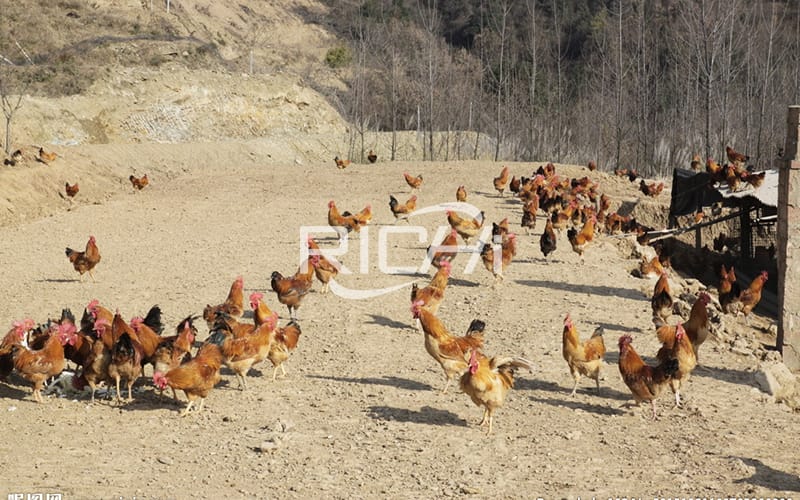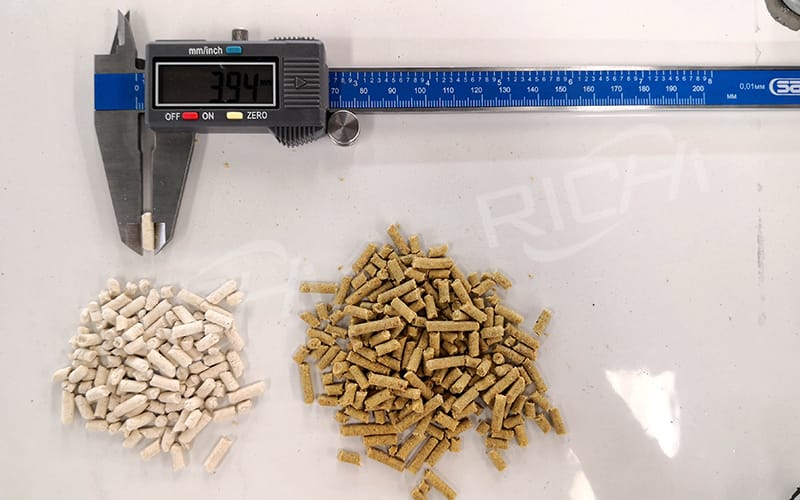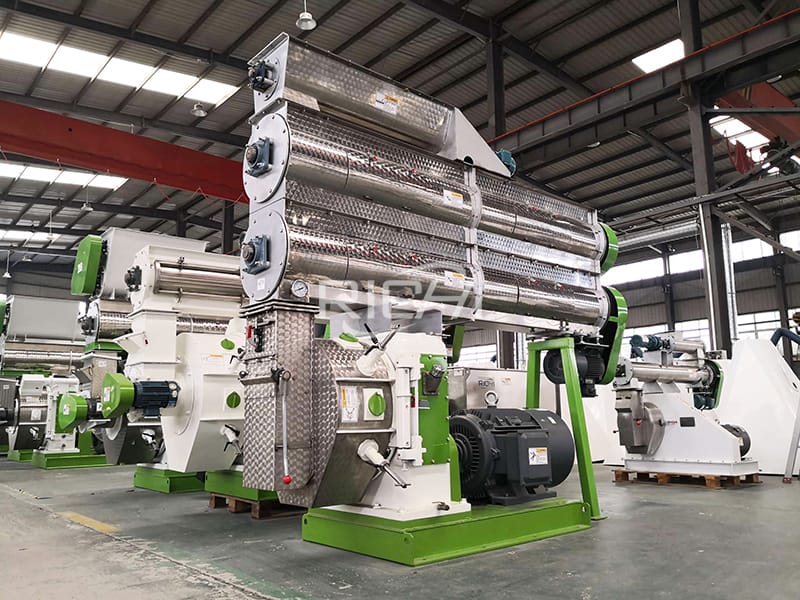Advantages of Broiler Feed Pellets
Broiler feed pellets have several advantages compared with powder feed, the main advantage of which is to improve the performance of broilers. Compared with broilers fed with powder, broilers fed with pellets require less time for feeding and digestion and have lower requirements for body maintenance.

1. The Quality of Broiler Feed Pellets
High-quality broiler feed pellets can be defined as feed pellets that can withstand repeated operations. For example, the feed pellets will not be damaged or produce too many fine particles during the process of bagging, transportation, storage and feeding line transportation. The quality of particles is usually expressed by the Pellet Durability Index (PDI), and can be measured in a tumbling tank: first, the particle sample to be tested is sieved to remove fine powder particles, and then rolled in the tumbling tank for a certain period of time. The tumbling sample is sieved to remove fine particles, so that the weight of intact particles can be obtained.
2. The Calculation Formula of PDI
PDI = weight of intact pellets after rolling / weight of intact particles before rolling × 100
Some other equipment can also be used to measure the durability of particles, such as Holman particle detector, wood detector, etc.
3. Factors Affecting the Quality of Feed Pellets
(1) Broiler Feed Formula

Some feed ingredients are good for improving pellet quality, while others may be bad. Unfortunately, corn-soybean meal diets are not ideal diets to achieve optimal pellet quality. As compared with corn or corn by-products, wheat contains high levels of protein (gluten) and hemicellulose, so diets added with wheat grains or wheat by-products (wheat gluten, wheat gluten) will have higher grains after pelleting Durability. Similarly, partial replacement of corn in the diet with oats can also improve the quality of feed pellets. We can sort according to the beneficial effects of feed grains on the quality of feed pellets, from best to worst: oats, wheat, barley, corn, sorghum.
We have long known that starch and its gelatinization are the most important factors for achieving the best quality of feed pellets. However, recent reports indicate that the beneficial effects of protein on the quality of feed pellets are far more important than starch.
- ① Adding oil to the diet will adversely affect the quality of feed pellets. This is because the oil will surround the feed pellets, which will hinder the penetration of steam into the pellets. In addition, the oil will also reduce the friction between the ring die and feed pellets, thereby reducing the gelatinization rate of starch.
- ② Adding binders [such as water (the simplest binder), lignosulfonate, hemicellulose extract, gelatin, etc.] and/or surfactants to the diet can improve the quality and yield of feed pellets, and can reduce energy consumption.
Feed Pellet Quality Factor (FPQF) is a tool that can be used to predict the quality of pellets in feed formulations.
Estimating the FPQF of a certain feed formula: Each feed ingredient has its own Pellet Quality Factor (PQF). The score of PQF is 0-10, where 0 means poor quality of feed pellets, and 10 means good quality of feed pellets. We can estimate the FPQF of each ingredient by multiplying its PQF value by its percentage in the formula. The FPQF value of a feed formula is equal to the sum of the FPQF of all raw materials used. Generally speaking, the FPQF value of the feed formula lower than 4.7 indicates poor feed pellet quality, and higher than 4.7 indicates good feed quality.
(2) The Particle Size of the Raw Material of the Broiler Pellet Feed
Although some researchers have doubts about this, most people still believe that reducing the particle size of feed ingredients is beneficial to improving the quality of feed pellets. However, we do not recommend excessive crushing to avoid wasting energy consumption and reducing productivity, and doing so is not conducive to broiler musculoskeletal development. On the other hand, coarse crushing by poultry chicken hammer mill grinder can reduce the decomposition of feed pellets and reduce the degree of starch gelatinization (the production of high-quality feed pellets requires a high degree of gelatinization).
(3) Steam Conditioning of Broiler Poultry Feed Pellet Mill Machine

When the powder passes through the conditioner, it will be exposed to high-pressure steam. This kind of steam will provide the high temperature and moisture required for starch gelatinization, make the pellets stick to each other, the feed is in a semi-digestible state, and can kill pathogens in the feed. The steam temperature and the time of the powder in the conditioner have a great influence on the durability of the feed pellets. Conditioning the feed at 80 ℃ is sufficient to produce high-quality broiler chicken feed pellets. To produce broiler chicken feed pellets with strong tolerance, the shortest time that the powder stays in the conditioning cylinder is 30 s. Long-term use of the conditioner (feed can stay in the conditioner for 3 min to 4 min) can be used to improve the viscosity of feed particles.
(4) Ring Die Specifications of Broiler Feed Pellet Making Machine
Pellet feed is produced by pressing hot powder into a ring die by pressing rollers. A thicker ring die (longer ring die channel) is beneficial to improve the durability of the feed pellets, because it can increase the friction time between the feed pellets and the ring die wall and make starch gelatinization more complete. Most starch gelatinization occurs when the feed passes through the ring die. Similar results can be obtained by using small aperture ring molds. This means that a 60 mm thick ring die is better than a 50 mm or 40 mm thick ring die, and the 3 mm ring die aperture is better than the 5 mm ring die aperture. However, a ring die with too thick or too small aperture has a negative impact on particle yield. In addition, increasing the distance between the pressure roller and the ring die from 0.1 mm to 2 mm can improve the durability of feed pellets.
(5) Broiler Feed Pellet Cooling Machine
When leaving the pellet mill, the temperature of the feed pellets is 70 ℃ ~ 90 ℃, and the humidity is 15% ~ 17%. Feed pellets need moderate cooling (using a steam cooler) to reduce the pellet temperature to about 8°C higher than the ambient temperature and reduce its humidity to 12%. The type of pellet cooler can be horizontal or vertical. Rapid cooling will cause more water and heat to be lost on the surface of the broiler feed pellet than inside the pellet, making the pellet brittle. On the other hand, long-term cooling will make the feed pellets too dry, and these pellets may be easily worn and have poor palatability.
More Related Knowledge About Broiler Pellet Feed
- Small broiler chicken feed pellet manufacturing plant
- Turn-key broiler chicken feed pellet plant 5 ton per hour
- 10t/h automatic complete poultry broiler feed pellet line with reasonable price
- How to make chicken feed pellet for broilers?
- Factory price boiler chicken poultry feed making machinery
- Broiler chicken feed pellet formulas
- Animal feed making machine poultry chicken broiler feed grinding and mixing machine for sale


